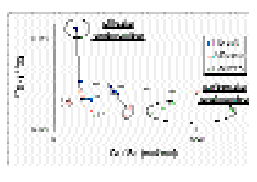
The aim of this study is to better understand the relationships between groundwaters and surficial waters in a medium-sized watershed (Hérault) through systematic use of various geochemical tracers : 1-Classically, major elements are used to discriminate between the different water types;
2-Trace elements allow to see the influence of human activity such as agriculture or mining activity; 3-Sr isotopes powerfully allow to define water circulations in reservoirs and mixing of waters from different origins (silicates, carbonates); 4-Pb isotopes are essential tools to discriminate natural versus anthropic metal sources; 5-Stable isotopes (18O, D/H) are very usefull to understand complex underground circulations and water origin(s).
The Hérault watershed measures 2500 km2, the Hérault stream is 150 km long and has 9 main tributaries. The principal geological constituants are silicates to the north, karstified carbonates and an alluvial plain dowstream to the estuary. The Hérault stream has been sampled systematically after the confluences of the different tributaries wich have been sampled too. The main karstic springs have also been sampled especially near Hérault. Sampling has been done during low flows (March 95) and during a high flow period (October 95). Samples were filtered on the same day under clean air on 0.2µ acid-cleaned Teflon filters for trace elements and isotopes (Sr, Pb), and on 0.4µ cellulose acetate filters for major elements. Samples were then acidified with sub-boiled HNO3 and kept at 4°C.
Trace elements and radiogenic isotopes analyses have been done on both dissolved and particulate phases. Strontium isotopes on the dissolved phase reveal the two main lithologic endmembers of the watershed: silicates and carbonates, and the Hérault Sr isotopic evolution from upstream to downstream. Sr isotopes (87Sr / 86Sr) versus X/Sr ratios allow us to reveal the different mixings of the main stream (Hérault) with tributaries and karstic springs. The Sr isotopic composition of the karstic springs linearly decrease with the distance to the contact between the silicate basement and the mesozoïc carbonate cover. Sr isotopes on the
particulate phase show higher 87Sr / 86Sr ratios because of the lower solubility of silicates versus carbonates.
Some trace elements in the dissolved phase are also good tracers: e.g. Pb and Zn originate from a Pb-Zn mine (see also Pb isotopes), the influence being visible down to the estuary. We can also see the influence of the Permian uraniferous basin of Lodève on the tributary which drains this part of the watershed, and on the main stream (Hérault) down to the estuary.
All samples plot +/- on a same trend with a slope of 6.1 in a dD”=f(d18O”) diagram. The effect of altitude and continentality are visible on the main stream as well as on the tributaries and karstic springs.
Fig. 1.